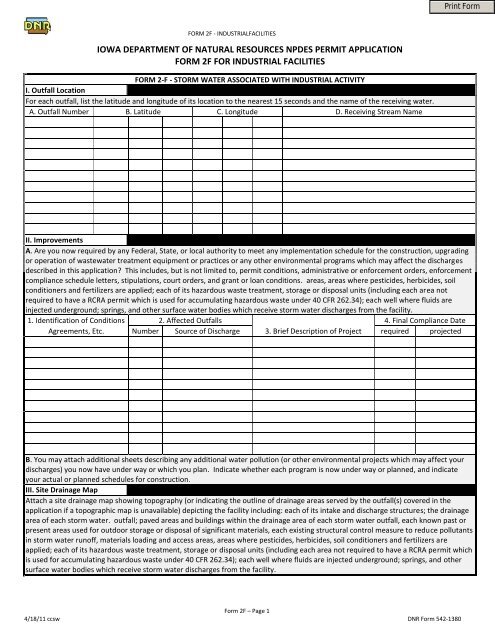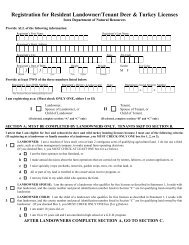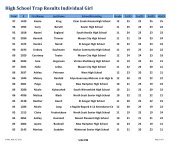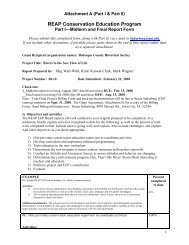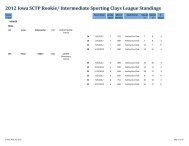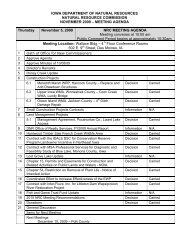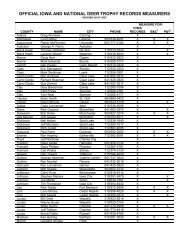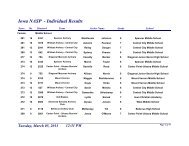iowa department of natural resources npdes permit application
iowa department of natural resources npdes permit application
iowa department of natural resources npdes permit application
Create successful ePaper yourself
Turn your PDF publications into a flip-book with our unique Google optimized e-Paper software.
FORM 2F - INDUSTRIALFACILITIES<br />
IOWA DEPARTMENT OF NATURAL RESOURCES NPDES PERMIT APPLICATION<br />
FORM 2F FOR INDUSTRIAL FACILITIES<br />
FORM 2-F - STORM WATER ASSOCIATED WITH INDUSTRIAL ACTIVITY<br />
I. Outfall Location<br />
For each outfall, list the latitude and longitude <strong>of</strong> its location to the nearest 15 seconds and the name <strong>of</strong> the receiving water.<br />
A. Outfall Number B. Latitude C. Longitude D. Receiving Stream Name<br />
II. Improvements<br />
A. Are you now required by any Federal, State, or local authority to meet any implementation schedule for the construction, upgrading<br />
or operation <strong>of</strong> wastewater treatment equipment or practices or any other environmental programs which may affect the discharges<br />
described in this <strong>application</strong>? This includes, but is not limited to, <strong>permit</strong> conditions, administrative or enforcement orders, enforcement<br />
compliance schedule letters, stipulations, court orders, and grant or loan conditions. areas, areas where pesticides, herbicides, soil<br />
conditioners and fertilizers are applied; each <strong>of</strong> its hazardous waste treatment, storage or disposal units (including each area not<br />
required to have a RCRA <strong>permit</strong> which is used for accumulating hazardous waste under 40 CFR 262.34); each well where fluids are<br />
injected underground; springs, and other surface water bodies which receive storm water discharges from the facility.<br />
1. Identification <strong>of</strong> Conditions 2. Affected Outfalls 4. Final Compliance Date<br />
Agreements, Etc. Number Source <strong>of</strong> Discharge 3. Brief Description <strong>of</strong> Project required projected<br />
B. You may attach additional sheets describing any additional water pollution (or other environmental projects which may affect your<br />
discharges) you now have under way or which you plan. Indicate whether each program is now under way or planned, and indicate<br />
your actual or planned schedules for construction.<br />
III. Site Drainage Map<br />
Attach a site drainage map showing topography (or indicating the outline <strong>of</strong> drainage areas served by the outfall(s) covered in the<br />
<strong>application</strong> if a topographic map is unavailable) depicting the facility including: each <strong>of</strong> its intake and discharge structures; the drainage<br />
area <strong>of</strong> each storm water. outfall; paved areas and buildings within the drainage area <strong>of</strong> each storm water outfall, each known past or<br />
present areas used for outdoor storage or disposal <strong>of</strong> significant materials, each existing structural control measure to reduce pollutants<br />
in storm water run<strong>of</strong>f, materials loading and access areas, areas where pesticides, herbicides, soil conditioners and fertilizers are<br />
applied; each <strong>of</strong> its hazardous waste treatment, storage or disposal units (including each area not required to have a RCRA <strong>permit</strong> which<br />
is used for accumulating hazardous waste under 40 CFR 262.34); each well where fluids are injected underground; springs, and other<br />
surface water bodies which receive storm water discharges from the facility.<br />
Form 2F – Page 1<br />
4/18/11 ccsw DNR Form 542-1380
FORM 2F - INDUSTRIALFACILITIES<br />
IV. Narrative Description <strong>of</strong> Pollutant Sources<br />
A. For each outfall, provide an estimate <strong>of</strong> the area (include units) <strong>of</strong> impervious surfaces (including paved areas and building ro<strong>of</strong>s)<br />
drained to the outfall, and an estimate <strong>of</strong> the total surface area drained by the outfall.<br />
Outfall Area <strong>of</strong> Impervious Surface Total Area Drained Outfall Area <strong>of</strong> Impervious Surface Total Area Drained<br />
Number (provide units) (provide units) Number (provide units) (provide units)<br />
B. Provide a narrative description <strong>of</strong> significant materials that are or have in the past three years have been treated, stored, or disposed<br />
in a manner to allow exposure to storm water; method <strong>of</strong> treatment, storage, or disposal; past and present materials management<br />
practices employed, in the last three years, to minimize contact by these materials with storm water run<strong>of</strong>f; materials loading and access<br />
areas; and the location, manner, and frequency in which pesticides, herbicides, soil conditioners, and fertilizers are applied.<br />
C. For each outfall, provide the location and a description <strong>of</strong> existing structural and nonstructural control measures to reduce pollutants<br />
in storm water run<strong>of</strong>f; and a description <strong>of</strong> the treatment the storm water receives, including the schedule and type <strong>of</strong> maintenance for<br />
control and treatment measures and the ultimate disposal <strong>of</strong> any solid or fluid wastes other than by discharge.<br />
Outfall Treatment List Codes from<br />
Number Table 2F-1<br />
V. Non-storm water Discharges<br />
All outfalls that contain storm water discharges associated with industrial activity must be tested or evaluated for the presence <strong>of</strong> nonstorm<br />
water discharges which are not covered by an NPDES <strong>permit</strong>. All non-storm water discharges must be identified in a Form 2, 3 or 4<br />
which must accompany this <strong>application</strong>. Below, provide a description <strong>of</strong> the testing or evaluation method used, the date <strong>of</strong> any testing,<br />
and the onsite drainage points that were directly observed during a test. Note: All applicants submitting Form 2F must Certify on Form 5<br />
that the outfall(s) covered by this <strong>application</strong> have been tested or evaluated for the presence <strong>of</strong> non-storm water discharges, and that all<br />
storm water discharges from the outfall(s) included in Form 2F are identified in either an accompanying Form 2 or Form 3.<br />
VI. Significant Leaks or Spills<br />
Provide existing information regarding the history <strong>of</strong> significant leaks or spills <strong>of</strong> toxic or hazardous pollutants at the facility in the last<br />
three years, including the approximate date and location <strong>of</strong> the spill or leak, and the type and amount <strong>of</strong> material released.<br />
Form 2F – Page 2<br />
4/18/11 ccsw DNR Form 542-1380
FORM 2F - INDUSTRIALFACILITIES<br />
VII. Discharge Information<br />
A, B, C, & D: See instructions before proceeding. Complete one set <strong>of</strong> tables for each outfall. Annotate the outfall number in the<br />
space provided.<br />
Part A - You must provide the results <strong>of</strong> at least one analysis for every pollutant in this table. Complete one table for each outfall. See<br />
instructions for additional details.<br />
Maximum Values<br />
(include units)<br />
Pollutant<br />
Oil and Grease<br />
Biochemical<br />
Oxygen Demand (BOD)<br />
Chemical Oxygen<br />
Demand (COD)<br />
Total Suspended<br />
Solids (TSS)<br />
Total Kjeldahl<br />
Nitrogen (TKN)<br />
Nitrate plus<br />
Nitrite Nitrogen<br />
Grab Sample<br />
Taken During<br />
First 30 Minutes<br />
Flowweighted<br />
Composite<br />
Average Values<br />
(include units)<br />
Grab Sample<br />
Taken During<br />
First 30 Minutes<br />
Flow-weighted<br />
Composite<br />
Total<br />
Phosphorus<br />
pH Minimum Maximum Minimum Maximum<br />
Number<br />
<strong>of</strong><br />
Storm<br />
Events<br />
Sampled<br />
Sources <strong>of</strong> Pollutants<br />
Certified<br />
Laboratory<br />
Number<br />
Part B – List each pollutant that is limited in an effluent guideline which the facility is subject to or any pollutant listed in the facility’s<br />
NPDES <strong>permit</strong> for its process wastewater (if the facility is operating under an existing NPDES <strong>permit</strong>). Complete one table for each<br />
outfall. See the instructions for additional details and requirements.<br />
Pollutant<br />
and<br />
CAS Number<br />
(if available)<br />
Maximum Values<br />
(include units)<br />
Grab Sample<br />
Taken During<br />
First 30 Minutes<br />
Flow-weighted<br />
Composite<br />
Grab Sample<br />
Taken During<br />
First 30 Minutes<br />
Average Values<br />
(include units)<br />
Flow-weighted<br />
Composite<br />
Number<br />
<strong>of</strong><br />
Storm<br />
Events<br />
Sampled<br />
Sources <strong>of</strong> Pollutants<br />
Certified<br />
Laboratory<br />
Number<br />
Form 2F – Page 3<br />
4/18/11 ccsw DNR Form 542-1380
FORM 2F - INDUSTRIALFACILITIES<br />
Part C - List each pollutant shown in Tables 2F-2, 2F-3, and 2F-4 that you know or have reason to believe is present. See the<br />
instructions for additional details and requirements. Complete one table for each outfall.<br />
Pollutant<br />
and<br />
Maximum Values<br />
(include units)<br />
Average Values<br />
(include units)<br />
Number<br />
<strong>of</strong><br />
Sources <strong>of</strong> Pollutants Certified<br />
Laboratory<br />
CAS Number<br />
(if available)<br />
Grab Sample<br />
Taken During<br />
First 30 Minutes<br />
Flow-weighted<br />
Composite<br />
Grab Sample<br />
Taken During<br />
First 30 Minutes<br />
Flow-weighted<br />
Composite<br />
Storm<br />
Events<br />
Sampled<br />
Number<br />
Part D - Provide data for the storm event(s) which resulted in the maximum values for the flow weighted composite sample.<br />
1. Date <strong>of</strong><br />
Storm Event<br />
2. Duration<br />
<strong>of</strong> Storm<br />
(in<br />
minutes)<br />
3. Total<br />
rainfall<br />
during storm<br />
event<br />
(in inches)<br />
4. Number <strong>of</strong> hours<br />
between beginning <strong>of</strong><br />
storm measured and end<br />
<strong>of</strong> previous measurable<br />
rain event<br />
5. Maximum flow<br />
rate during rain<br />
event<br />
(gallons /minute or<br />
specify units)<br />
6. Total flow<br />
from rain<br />
event<br />
(gallons or<br />
specify units)<br />
7. Season<br />
sample was<br />
taken<br />
8. Form <strong>of</strong><br />
precipitation<br />
(rainfall,<br />
snowmelt)<br />
9. Provide a description <strong>of</strong> the method <strong>of</strong> flow measurement or estimate.<br />
Form 2F – Page 4<br />
4/18/11 ccsw DNR Form 542-1380
FORM 2F - INDUSTRIALFACILITIES<br />
Part E - Potential discharges not covered by analysis - Is any pollutant listed in Table 2F-2 a substance or a component <strong>of</strong> a substance<br />
which you currently use or manufacture as an intermediate or final product or byproduct?<br />
Yes (list all such pollutants below)<br />
No<br />
VIII. Biological Toxicity Testing Data<br />
Do you have any knowledge or reason to believe that any biological test for acute or chronic toxicity has been made on any <strong>of</strong> your<br />
discharges or on a receiving water in relation to your discharge within the last 3 years?<br />
Yes (list all such pollutants below)<br />
No<br />
END OF FORM 2F<br />
Form 2F – Page 5<br />
4/18/11 ccsw DNR Form 542-1380
FORM 2F INSTRUCTIONS DO NOT SUBMIT THESE PAGES – FOR APPLICANT USE ONLY<br />
FORM 2F – INSTRUCTIONS<br />
DISCHARGE OF STORM WATER ASSOCIATED WITH INDUSTRIAL ACTIVITY<br />
Item I - You may use the map you provided with Form 1 to determine the latitude and longitude <strong>of</strong> each <strong>of</strong> your outfalls<br />
and the name <strong>of</strong> the receiving water.<br />
Item II-A - If you check “yes” to this question, complete all parts <strong>of</strong> the chart, or provide a reference to any previous<br />
submission you have made containing the same information.<br />
Item II-B - You are not required to submit a description <strong>of</strong> future pollution control projects if you do not wish to or if<br />
none is planned.<br />
Item III - Attach a site map showing topography (or indicating the outline <strong>of</strong> drainage areas served by the outfall(s)<br />
covered in the <strong>application</strong>) depicting the facility including:<br />
a) each <strong>of</strong> its drainage and discharge structures;<br />
b) the drainage area <strong>of</strong> each storm water outfall;<br />
c) paved areas and buildings within the drainage area <strong>of</strong> each storm water outfall, each known past or present area<br />
used for outdoor storage or disposal <strong>of</strong> significant materials, each existing structural control measure to reduce<br />
pollutants in storm water run<strong>of</strong>f, materials loading and access areas, areas where pesticides, herbicides, soil<br />
conditioners and fertilizers are applied;<br />
d) each <strong>of</strong> its hazardous waste treatment, storage or disposal facilities (including each area not required to have a<br />
RCRA <strong>permit</strong> which is used for accumulating hazardous waste for less than 90 days under 40 CFR 262.34) ;<br />
e) each well where fluids from the facility are injected underground; and<br />
f) springs, and other surface water bodies which receive storm water discharges from the facility;<br />
Item IV-A - For each outfall, provide an estimate <strong>of</strong> the area drained by the outfall which is covered by impervious<br />
surfaces. For the purpose <strong>of</strong> this <strong>application</strong>, impervious surfaces are surfaces where storm water runs <strong>of</strong>f at rates that<br />
are significantly higher than background rates (e.g., predevelopment levels) and include paved areas, building ro<strong>of</strong>s,<br />
parking lots, and roadways. Include an estimate <strong>of</strong> the total area (including all impervious and pervious areas) drained<br />
by each outfall. The site map required under Item III can be used to estimate the total area drained by each outfall.<br />
Item IV-B - Provide a narrative description <strong>of</strong> significant materials that are currently or in the past three years have been<br />
treated, stored, or disposed in a manner to allow exposure to storm water; method <strong>of</strong> treatment, storage or disposal <strong>of</strong><br />
these materials; past and present materials management practices employed, in the last three years, to minimize<br />
contact by these materials with storm water run<strong>of</strong>f; materials loading and access areas: and the location, manner, and<br />
frequency in which pesticides, herbicides, soil conditioners, and fertilizers are applied. Significant materials should be<br />
identified by chemical name, form (e.g., powder, liquid, etc.), and type <strong>of</strong> container or treatment unit. Indicate any<br />
materials treated, stored, or disposed <strong>of</strong> together. "Significant materials" includes, but is not limited to: raw materials;<br />
fuels; materials such as solvents, detergents, and plastic pellets; finished materials such as metallic products; raw<br />
materials used in food processing or production; hazardous substances designated under Section 101(14) <strong>of</strong> CERCLA;<br />
any chemical the facility is required to report pursuant to Section 313 <strong>of</strong> Title III <strong>of</strong> SARA; fertilizers; pesticides; and<br />
waste products such as ashes, slag and sludge that have the potential to be released with storm water discharges.<br />
Item IV-C - For each outfall, structural controls include structures which enclose material handling or storage areas,<br />
covering materials, berms, dikes, or diversion ditches around manufacturing, production, storage or treatment units,<br />
retention ponds, etc. Nonstructural controls include practices such as spill prevention plans, employee training, visual<br />
inspections, preventive maintenance, and housekeeping measures that are used to prevent or minimize the potential for<br />
releases <strong>of</strong> pollutants.<br />
Item V - Test or evaluate all outfalls that should contain storm water discharges associated with industrial activity for the<br />
presence <strong>of</strong> non-storm water discharges which are not covered by an NPDES <strong>permit</strong>. Tests for such non-storm water<br />
discharges may include smoke tests, fluorometric dye tests, analysis <strong>of</strong> accurate schematics, as well as other appropriate<br />
Form 2F – Page 6<br />
4/18/11 ccsw DNR Form 542-1380
FORM 2F INSTRUCTIONS DO NOT SUBMIT THESE PAGES – FOR APPLICANT USE ONLY<br />
tests. Include a description <strong>of</strong> the method used, the date <strong>of</strong> any testing, and the onsite drainage points that were<br />
directly observed during a test. All non-storm water discharges must be identified in a Form 2, Form 3 or Form 4 which<br />
must accompany this <strong>application</strong> (see general instructions for a description <strong>of</strong> when Form 2, Form 3 or Form 4 must be<br />
submitted). All <strong>application</strong>s submitting Form 2F must Certify on Form 5 that the outfall(s) covered by this <strong>application</strong><br />
have been testes tested or evaluated for the presence <strong>of</strong> non storm water discharges, and that all storm water<br />
discharges from the outfall(s) included in Form 2F are identified in either an accompanying Form 2 or Form 3.<br />
Item VI - Provide a description <strong>of</strong> existing information regarding the history <strong>of</strong> significant leaks or spills <strong>of</strong> toxic or<br />
hazardous pollutants at the facility in the last three years.<br />
Item VII-A, B, and C - These items require you to collect and report data on the pollutants discharged from each <strong>of</strong> your<br />
outfalls. Each part <strong>of</strong> this item addresses a different set <strong>of</strong> pollutants and must be completed in accordance with the<br />
specific instructions for that part. The following general instructions apply to the entire item.<br />
General Instructions:<br />
Part A requires you to report at least one analysis for each pollutant listed. Parts B and C require you to report analytical<br />
data in two ways. For some pollutants addressed in Parts B and C, if you know or have reason to know that the pollutant<br />
is present in your discharge, you may be required to list the pollutant and test (sample and analyze) and report the levels<br />
<strong>of</strong> the pollutants in your discharge. For all other pollutants addressed in Parts B and C, you must list the pollutant if you<br />
know or have reason to know that the pollutant is present in the discharge, and either report quantitative data for the<br />
pollutant or briefly describe the reasons the pollutant is expected to be discharged. (See specific instructions on the<br />
form and below for Parts A through C). Base your determination that a pollutant is present in or absent from your<br />
discharge on your knowledge <strong>of</strong> your raw materials, material management practices, maintenance chemicals, history <strong>of</strong><br />
spills and releases, intermediate and final products and byproducts, and any previous analyses known to you <strong>of</strong> your<br />
effluent or similar effluent.<br />
A. Sampling: The collection <strong>of</strong> the samples for the reported analyses should be supervised by a person experienced in<br />
performing sampling <strong>of</strong> industrial wastewater or storm water discharges. You may contact the <strong>department</strong> for detailed<br />
guidance on sampling techniques and for answers to specific questions. Any specific requirements contained in the<br />
applicable analytical methods must be followed for sample containers, sample preservation, holding times, the<br />
collection <strong>of</strong> duplicate samples, etc. The time when you sample should be representative, to the extent feasible, <strong>of</strong> your<br />
treatment system operating properly with no system upsets. Samples should be collected from the center <strong>of</strong> the flow<br />
channel, where turbulence is at a maximum, at a site specified in your present <strong>permit</strong>, or at any site adequate for the<br />
collection <strong>of</strong> a representative sample.<br />
For pH, temperature, cyanide, total phenols, residual chlorine, oil and grease, and Escherichia coli (E. coli), grab samples<br />
taken during the first 30 minutes (or as soon thereafter as practicable) <strong>of</strong> the discharge must be used (you are not<br />
required to analyze a flow-weighted composite for these parameters). For all other pollutants, both a grab sample<br />
collected during the first 30 minutes (or as soon thereafter as practicable) <strong>of</strong> the discharge and a flow-weighted<br />
composite sample must be analyzed. However, a minimum <strong>of</strong> one grab sample may be taken for effluents from holding<br />
ponds or other impoundments with a retention period <strong>of</strong> greater than 24 hours.<br />
All samples shall be collected from a discharge resulting from a storm event that is greater than 0.1 inches and at least<br />
72 hours from the previously measurable (greater than 0.1 inch rainfall) storm event. Where feasible, the variance in<br />
the duration <strong>of</strong> the event and the total rainfall <strong>of</strong> the event should not exceed 50 percent from the average or median<br />
rainfall event in that area.<br />
Data from samples taken in the past may be used, provided that:<br />
i. All data requirements are met;<br />
ii. Sampling was done no more than three years before submission; and<br />
iii. All data are representative <strong>of</strong> the present discharge.<br />
Form 2F – Page 7<br />
4/18/11 ccsw DNR Form 542-1380
FORM 2F INSTRUCTIONS DO NOT SUBMIT THESE PAGES – FOR APPLICANT USE ONLY<br />
Among the factors which would cause the data to be unrepresentative are significant changes in production level,<br />
changes in raw materials, processes, or final products, and changes in storm water treatment. The Director may request<br />
additional information, including current quantitative data, if they determine it to be necessary to assess your<br />
discharges. The Director may allow or establish appropriate site-specific sampling procedures or requirements,<br />
including sampling locations, the season in which the sampling takes place, the minimum duration between the previous<br />
measurable storm event and the storm event sampled, the minimum or maximum level <strong>of</strong> precipitation required for an<br />
appropriate storm event, the form <strong>of</strong> precipitation sampled (snow melt or rainfall), protocols for collecting samples<br />
under 40 CFR Part 136, and additional time for submitting data on a case-by-case basis.<br />
B. Reporting: All levels must be reported as concentration and as total mass. You may report some or all <strong>of</strong> the required<br />
data by attaching separate sheets <strong>of</strong> paper instead <strong>of</strong> filling out pages 2F-4 and 2F-5 if the separate sheets contain all the<br />
required information in a format which is consistent with pages 2F-4 and 2F-5 in spacing and in identification <strong>of</strong><br />
pollutants and columns. Use the following abbreviations in the columns headed “Units.”<br />
ppm<br />
mg/1<br />
ppb<br />
ug/1<br />
kg<br />
Concentration<br />
parts per million<br />
milligrams per liter<br />
parts per billion<br />
micrograms per liter<br />
kilograms<br />
Ibs<br />
ton<br />
mg<br />
g<br />
T<br />
Mass<br />
pounds<br />
tons (English tons)<br />
milligrams<br />
grams<br />
tonnes (metric tons)<br />
All reporting <strong>of</strong> values for metals must be in terms <strong>of</strong> “total metal,” unless:<br />
1. An applicable, promulgated effluent limitation or standard specifies the limitation for the metal in dissolved, valent,<br />
or total form; or<br />
2. All approved analytical methods for the metal inherently measure only its dissolved form (e.g., hexavalent<br />
chromium).<br />
The <strong>department</strong> has determined that in establishing case-by-case limitations it is necessary to express the limitations on<br />
the metal in dissolved, valent, or total form to carry out the provisions <strong>of</strong> the CWA. If you measure only one grab sample<br />
and one flow-weighted composite sample for a given outfall, complete only the “Maximum Values” columns and insert<br />
“1” into the “Number <strong>of</strong> Storm Events Sampled” column. The <strong>permit</strong>ting authority may require you to conduct<br />
additional analyses to further characterize your discharges.<br />
If you measure more than one value for a grab sample or a flow-weighted composite sample for a given outfall and<br />
those values are representative <strong>of</strong> your discharge, you must report them. You must describe your method <strong>of</strong> testing and<br />
data analysis. You also must determine the average <strong>of</strong> all values within the last year and report the concentration and<br />
mass under the “Average Values” columns, and the total number <strong>of</strong> storm events sampled under the “Number <strong>of</strong> Storm<br />
Events Sampled” columns.<br />
C. Analysis: You must use test methods promulgated in 40 CFR Part 136; however, if none has been promulgated for a<br />
particular pollutant, you may use any suitable method for measuring the level <strong>of</strong> the pollutant in your discharge. If you<br />
have two or more substantially identical outfalls, you may request permission to sample and analyze only one outfall<br />
and submit the results <strong>of</strong> the analysis for other substantially identical outfalls. If your request is granted by the<br />
<strong>department</strong>, on a separate sheet attached to the <strong>application</strong> form, identify which outfall you did test, and describe why<br />
the outfalls which you did not test are substantially identical to the outfall which you did test.<br />
Part VII-A - Part VII-A must be completed by all applicants for all outfalls who must complete Form 2F. Analyze a grab<br />
sample collected during the first thirty minutes (or as soon thereafter as practicable) <strong>of</strong> the discharge and flow-weighted<br />
composite samples for all pollutants in this Part, and report the results except use only grab samples for pH and oil and<br />
grease. The “Average Values” column is not compulsory; but should be filled out if data are available.<br />
Form 2F – Page 8<br />
4/18/11 ccsw DNR Form 542-1380
FORM 2F INSTRUCTIONS DO NOT SUBMIT THESE PAGES – FOR APPLICANT USE ONLY<br />
Part VII-B - List all pollutants that are limited in an effluent guideline which the facility is subject to (see 40 CFR<br />
Subchapter N to determine which pollutants are limited in effluent guidelines) or any pollutant listed in the facility's<br />
NPDES <strong>permit</strong> for its process wastewater (if the facility is operating under an existing NPDES <strong>permit</strong>). Complete one<br />
table for each outfall. The “Average Values” column is not compulsory; but should be filled out if data are available.<br />
Analyze a grab sample collected during the first thirty minutes <strong>of</strong> the discharge and flow-weighted composite samples<br />
for all pollutants in this Part, and report the results, except as provided in the General Instructions.<br />
Part VII-C - Part VII-C must be completed by all applicants for all outfalls which discharge storm water associated with<br />
industrial activity, or that the State <strong>of</strong> Iowa is evaluating for designation as a significant contributor <strong>of</strong> pollutants to<br />
waters <strong>of</strong> the state, or as contributing to a violation <strong>of</strong> a water quality standard. Use both a grab sample and a<br />
composite sample for all pollutants you analyze for in this part except use grab samples for residual chlorine and<br />
Escherichia coli (E. coli). The “Average Values” column is not compulsory but should be filled out if data are available.<br />
Part C requires you to address the pollutants in Table 2F-2, 2F-3, and 2F-4 for each outfall. Pollutants in each <strong>of</strong> these<br />
Tables are addressed differently.<br />
Table 2F-2: For each outfall, list all pollutants in Table 2F-2 that you know or have reason to believe are discharged<br />
(except pollutants previously listed in Part Vll-B). If a pollutant is limited in an effluent guideline limitation to which the<br />
facility is subject (e.g., use <strong>of</strong> TSS as an indicator to control the discharge <strong>of</strong> iron and aluminum), the pollutant should be<br />
listed in Part Vll-B. If a pollutant in table 2F-2 is indirectly limited by an effluent guideline limitation through an<br />
indicator, you must analyze for it and report data in Part Vll-C. For other pollutants listed in Table 2F-2 (those not<br />
limited directly or indirectly by an effluent limitation guideline), that you know or have reason to believe are discharge,<br />
you must either report quantitative data or briefly describe the reason the pollutant is expected to be discharged.<br />
Table 2F-3: For each outfall, list all pollutants in Table 2F-3 that you know or have reason to believe are discharged. For<br />
every pollutant in Table 2F-3 expected to be discharged in concentrations <strong>of</strong> 10 ppb or greater, you must submit<br />
quantitative data. For acrolein, acrylonitrile, 2, 4 dinitrophenol, and 2-methyl-4, 6 dinitrophenol, you must submit<br />
quantitative data if any <strong>of</strong> these four pollutants is expected to be discharged in concentrations <strong>of</strong> 100 ppb or greater.<br />
For every pollutant expected to be discharged in concentrations less than 10 ppb (or 100 ppb for the four pollutants<br />
listed above), then you must either submit quantitative data or briefly describe the reason the pollutant is expected to<br />
be discharged.<br />
Small Business Exemption - If you are a “small business,” you are exempt from the reporting requirements for the<br />
organic toxic pollutants listed in Table 2F-3. There are two ways in which you can qualify as a “small business”.<br />
i. If your facility is a coal mine, and if your probable total annual production is less than 100,000 tons per year, you<br />
may submit past production data or estimated future production (such as a schedule <strong>of</strong> estimated total<br />
production under 30 CFR 795.14(c)) instead <strong>of</strong> conducting analyses for the organic toxic pollutants.<br />
ii. If your facility is not a coal mine, and if your gross total annual sales for the most recent three years average less<br />
than $100,000 per year (in second quarter 1980 dollars), you may submit sales data for those years instead <strong>of</strong><br />
conducting analyses for the organic toxic pollutants. The production or sales data must be for the facility which is<br />
the source <strong>of</strong> the discharge.<br />
The production or sales data must be for the facility which is the source <strong>of</strong> the discharge. The data should not be limited<br />
to production or sales for the process or processes which contribute to the discharge, unless those are the only<br />
processes at your facility. For sales data, in situations involving intracorporate transfer <strong>of</strong> goods and services, the<br />
transfer price per unit should approximate market prices for those goods and services as closely as possible. Sales<br />
figures for years after 1980 should be indexed to the second quarter <strong>of</strong> 1980 by using the gross national product price<br />
deflator (second quarter <strong>of</strong> 1980= 100). This index is available in National Income and Product Accounts <strong>of</strong> the United<br />
States (Department <strong>of</strong> Commerce, Bureau <strong>of</strong> Economic Analysis).<br />
Form 2F – Page 9<br />
4/18/11 ccsw DNR Form 542-1380
FORM 2F INSTRUCTIONS DO NOT SUBMIT THESE PAGES – FOR APPLICANT USE ONLY<br />
Table 2F-4: For each outfall, list any pollutant in Table 2F-4 that you know or believe to be present in the discharge and<br />
explain why you believe it to be present. No analysis is required, but if you have analytical data, you must report them.<br />
Note: Under 40 CFR 117.12(a)(2), certain discharges <strong>of</strong> hazardous substances listed at 40 CFR 177.21 or 40 CFR 302.4<br />
may be exempted from the requirements <strong>of</strong> section 311 <strong>of</strong> CWA, which establishes reporting requirements, civil<br />
penalties, and liability for cleanup costs for spills <strong>of</strong> oil and hazardous substances. A discharge <strong>of</strong> a particular substance<br />
may be exempted if the origin, source, and amount <strong>of</strong> the discharged substances are identified in the NPDES <strong>permit</strong><br />
<strong>application</strong> or in the <strong>permit</strong>, if the <strong>permit</strong> contains a requirement for treatment <strong>of</strong> the discharge, and if the treatment is<br />
in place. To apply for an exclusion <strong>of</strong> the discharge <strong>of</strong> any hazardous substance from the requirements <strong>of</strong> section 311,<br />
attach additional sheets <strong>of</strong> paper to your form, setting forth the following information:<br />
1. The substance and the amount <strong>of</strong> each substance which may be discharged.<br />
2. The origin and source <strong>of</strong> the discharge <strong>of</strong> the substance.<br />
3. The treatment which is to be provided for the discharge by:<br />
a) An onsite treatment system separate from any treatment system treating your normal discharge;<br />
b) A treatment system designed to treat your normal discharge and which is additionally capable <strong>of</strong> treating the<br />
amount <strong>of</strong> the substance identified under paragraph 1 above; or<br />
c) Any combination <strong>of</strong> the above.<br />
See 40 CFR 117.12(a)(2) and (c), published on August 29, 1979, in 44 FR 50766, or contact the <strong>department</strong> for further<br />
information on exclusions from section 311.<br />
Part VII-D - If sampling is conducted during more than one storm event, you only need to report the information<br />
requested in Part Vll-D for the storm event(s) which resulted in any maximum pollutant concentration reported in Part<br />
VII-A, VII-B, or VII-C. Provide flow measurements or estimates <strong>of</strong> the flow rate, and the total amount <strong>of</strong> discharge for the<br />
storm event(s) sampled and the method <strong>of</strong> flow measurement or estimation. Provide the duration <strong>of</strong> the storm event(s)<br />
sampled, rainfall measurements, or estimates <strong>of</strong> the storm event which generated the sampled run<strong>of</strong>f and the duration<br />
between the storm event sampled and the end <strong>of</strong> the previous measurable (greater than 0.1 inch rainfall) storm event.<br />
Part VII-E - List any toxic pollutant listed in Tables 2F-2, 2F-3, or 2F-4 which you currently use or manufacture as an<br />
intermediate or final product or byproduct. In addition, if you know or have reason to believe that 2,3,7,8-<br />
tetrachlorodibenzo-p-dioxin (TCDD) is discharged or if you use or manufacture 2,4,5-trichlorophenoxy acetic acid (2,4,5,-<br />
T), 2-(2,4,5-trichlorophenoxy) propanoic acid (Silvex, 2,4,5,-TP), 2-(2,4,5-trichlorophenoxy) ethyl, 2,2-dichloropropionate<br />
(Erbon), 0,0 dimethyl 0-(2,4,5-trichlorphenyl) phosphorothioate (Ronnel), 2,4,5-trichlorophenol (TCP), or<br />
hexachlorophene (HCP), then list TCDD. The Director may waive or modify this requirement if you demonstrate that it<br />
would be unduly burdensome to identify each toxic pollutant and the Director has adequate information to issue your<br />
<strong>permit</strong>. You may not claim this information as confidential; however, you do not have to distinguish between use or<br />
production <strong>of</strong> the pollutants or list the amounts.<br />
Item VIII - Self explanatory. The <strong>department</strong> may ask you to provide additional details after your <strong>application</strong> is received.<br />
Form 2F – Page 10<br />
4/18/11 ccsw DNR Form 542-1380
FORM 2F INSTRUCTIONS DO NOT SUBMIT THESE PAGES – FOR APPLICANT USE ONLY<br />
Table 2F-1<br />
Codes for Treatment Units<br />
Physical Treatment Processes<br />
1-A Ammonia Stripping 1-M Grit Removal<br />
1-B Dialysis 1-N Microstraining<br />
1-C Diatomaceous Earth Filtration 1-O Mixing<br />
1-D Distillation 1-P Moving Bed Filters<br />
1-E Electrodialysis 1-Q Multimedia Filtration<br />
1-F Evaporation 1-R Rapid Sand Filtration<br />
1-G Flocculation 1-S Reverse Osmosis (Hyperfiltration)<br />
1-H Rotation 1-T Screening<br />
1-I Foam Fractionation 1-U Sedimentation (Settling)<br />
1-J Freezing 1-V Slow Sand Filtration<br />
1-K Gas-Phase Separation 1-W Solvent Extraction<br />
1-L Grinding (Comminutors) 1-X Sorption<br />
Chemical Treatment Processes<br />
2-A Carbon Adsorption 2-G Disinfection (Ozone)<br />
2-B Chemical oxidation 2-H Disinfection (Other)<br />
2-C Chemical Precipitation 2-I Electrochemical Treatment<br />
2-D Coagulation 2-J Ion Exchange<br />
2-E Dechlorination 2-K Neutralization<br />
2-F Disinfection (Chlorine) 2-L Reduction<br />
Biological Treatment Processes<br />
3-A Activated Sludge 3-E Pre-Aeration<br />
3-B Aerated Lagoons 3-F Spray Irrigation/Land Application<br />
3-C Anaerobic Treatment 3-G Stabilization Ponds<br />
3-D Nitrification-Denitrification 3-H Trickling Filtration<br />
Other Processes<br />
4-A Discharge to Surface Water 4-C Reuse/Recycle <strong>of</strong> Treated Effluent<br />
4-B Ocean Discharge Through Outfall 4-D Underground Injection<br />
Sludge Treatment and Disposal Processes<br />
5-A Aerobic Digestion 5-M Heat Drying<br />
5-B Anaerobic Digestion 5-N Heat Treatment<br />
5-C Belt Filtration 5-0 Incineration<br />
5-D Centrifugation 5-P Land Application<br />
5-E Chemical Conditioning 5-Q Landfill<br />
5-F Chlorine Treatment 5-R Pressure Filtration<br />
5-G Composting 5-S Pyrolysis<br />
5-H Drying Beds 5-T Sludge Lagoons<br />
5-I Elutriation 5-U Vacuum Filtration<br />
5-J Floatation Thickening 5-V Vibration<br />
5-K Freezing 5-W Wet Oxidation<br />
5-L Gravity Thickening<br />
Form 2F – Page 11<br />
4/18/11 ccsw DNR Form 542-1380
FORM 2F INSTRUCTIONS DO NOT SUBMIT THESE PAGES – FOR APPLICANT USE ONLY<br />
Table 2F-2<br />
Conventional and Non-conventional Pollutants Required To Be Tested by Existing Discharger if Expected To Be Present<br />
Bromide Phosphorus, Total Radioactivity Boron<br />
Chlorine, Total Residual Sulfate Cobalt<br />
Color Sulfide Iron<br />
Escherichia coli (E. coli) Sulfite Magnesium<br />
Fluoride Surfactants Molybdenum<br />
Nitrate-Nitrite Aluminum, Total Tin<br />
Nitrogen, Total Kjeldahl Barium, Total Titanium<br />
Oil and Grease<br />
Table 2F-3<br />
Toxic Pollutants Required to be Identified by Applicant if Expected to be Present<br />
Toxic Pollutants and Total Phenols<br />
Antimony<br />
Arsenic, Total<br />
Beryllium, Total<br />
Cadmium, Total<br />
Chromium, Total<br />
GC/MS Fraction Volatiles Compounds<br />
Acrolein<br />
Acrylonitrile<br />
Benzene<br />
Brom<strong>of</strong>orm<br />
Carbon Tetrachloride<br />
Chlorobenzene<br />
Chlorodibromomethane<br />
Chloroethane<br />
2-Chloroethylvinyl Ether<br />
Chlor<strong>of</strong>orm<br />
Acid Compounds<br />
2-Chlorophenol<br />
2,4-Dichlorophenol<br />
2,4-Dimethylphenol<br />
4,6-Dinitro-O-Cresol<br />
Copper, Total<br />
Lead, Total<br />
Mercury, Total<br />
Nickel, Total<br />
Selenium, Total<br />
Dichlorobromomethane<br />
1,1-Dichloroethane<br />
1,2-Dichloroethane<br />
1,1-0ichloroethylene<br />
1,2-Dichloropropane<br />
1,3-Dichloropropylene<br />
Ethylbenzene<br />
Methyl Bromide<br />
Methyl Chloride<br />
Methylene Chloride<br />
2,4-Dinitrophenol<br />
2-Nitrophenol<br />
4-Nitrophenol<br />
p-Chloro-M-Cresol<br />
Silver, Total<br />
Thallium, Total<br />
Zinc, Total<br />
Cyanide, Total<br />
Phenols, Total<br />
1,1,2,2,-Tetrachloroethane<br />
Tetrachloroethylene<br />
Toluene<br />
1,2-Trans-Dichloroethylene<br />
1,1,1-Trichloroethane<br />
1,1,2-Trichioroethane<br />
Trichloroethylene<br />
Vinyl Chloride<br />
Pentachlorophenol<br />
Phenol<br />
2,4,6-Trichlorophenol<br />
Base/Neutral<br />
Acenaphthene<br />
Acenaphthylene<br />
Anthracene<br />
Benzidine<br />
Benzo(a)anthracene<br />
Benzo(a)pyrene<br />
3,4-Benz<strong>of</strong>luoranthene<br />
Benzo(ghi)perylene<br />
Benzo(k)fluoranthene<br />
Bis(2-chloroethoxy)methane<br />
Bis(2-chloroethyl)ether<br />
Bis(2-chloroisopropyl)ether<br />
Bis(2-ethylyhexyl) phthalate<br />
4-Bromophenyl Phenyl Ether<br />
Butylbenzyl Phthalate<br />
2-Chloronaphthalene<br />
4-Chlorophenyl Phenyl Ether<br />
Chrysene<br />
Dibenzo(a,h)anthracene<br />
1,2-Dichlorobenzene<br />
1,3-Dichlorobenzene<br />
1,4-Dichlorobenzene<br />
3,3'-Dichlorobenzidine<br />
Diethyl Phthalate<br />
Dimethyl Phthalate<br />
Di-N-Butyl Phthalate<br />
2,4-Dinitrotoluene<br />
2,6-Dinitrotoluene<br />
Di-N-Octylphthalate<br />
1,2-Diphenylhydrazine (as Azobenzene)<br />
Fluroranthene<br />
Fluorene<br />
Hexachlorobenzene<br />
Hexachlorobutadiene<br />
Hexachloroethane<br />
Indeno(1,2,3-cd)pyrene<br />
Isophorone<br />
Napthalene<br />
Nitrobenzene<br />
N-Nitrosodimethylamine<br />
N-Nitrosodi-N-Propylamine<br />
N-Nitrosodiphenylamine<br />
Phenanthrene<br />
Pyrene<br />
1,2,4-Trichlorobenzene<br />
Pesticides<br />
Aldrin<br />
Alpha-BHC<br />
Beta-BHC<br />
Gamma-BHC<br />
Delta-BHC<br />
Chlordane<br />
4,4'-DDT<br />
4,4'-DDE<br />
4,4'-DDD<br />
Dieldrin<br />
Alpha-Endosulfan<br />
Beta-Endosulfan<br />
Endosulfan Sulfate<br />
Endrin<br />
Endrin Aldehyde<br />
Heptachlor<br />
Heptachlor Epoxide<br />
PCB-1242<br />
PCB-1254<br />
PCB-1221<br />
PCB-1232<br />
PCB-1248<br />
PCB-1260<br />
PCB-1016<br />
Toxaphene<br />
Form 2F – Page 12<br />
4/18/11 ccsw DNR Form 542-1380
FORM 2F INSTRUCTIONS DO NOT SUBMIT THESE PAGES – FOR APPLICANT USE ONLY<br />
Table 2F-4<br />
Hazardous Substances Required to be Identified by Applicant if Expected to be Present<br />
Toxic Pollutant<br />
Asbestos<br />
Hazardous Substances<br />
Acetaldehyde<br />
Allyl alcohol<br />
Allyl chloride<br />
Amyl acetate<br />
Aniline<br />
Benzonitrile<br />
Benzyl chloride<br />
Butyl acetate<br />
Butylamine<br />
Carbaryl<br />
Carb<strong>of</strong>uran<br />
Carbon disulfide<br />
Chlorpyrifos<br />
Coumaphos<br />
Cresol<br />
Crotonaldehyde<br />
Cyclohexane<br />
2,4-D (2,4-Dichlorophenoxyacetic acid)<br />
Diazinon<br />
Dicamba<br />
Dichlobenil<br />
Dichlone<br />
2,2-Dichloropropionic acid<br />
Dichlorvos<br />
Diethyl amine<br />
Dimethyl amine<br />
Dinitrobenzene<br />
Diquat<br />
Disulfoton<br />
Diuron<br />
Epichlorohydrin<br />
Ethion<br />
Ethylene diamine<br />
Ethylene dibromide<br />
Formaldehyde<br />
Furfural<br />
Guthion<br />
Isoprene<br />
Isopropanolamine<br />
Kelthane<br />
Kepone<br />
Malathion<br />
Mercaptodimethur<br />
Methoxychlor<br />
Methyl mercaptan<br />
Methyl methacrylate<br />
Methyl parathion<br />
Mevinphos<br />
Mexacarbate<br />
Monoethyl amine<br />
Monomethyl amine<br />
Naled<br />
Napthenic acid<br />
Nitrotoluene<br />
Parathion<br />
Phenolsulfonate<br />
Phosgene<br />
Propargite<br />
Propylene oxide<br />
Pyrethrins<br />
Quinoline<br />
Resorcinol<br />
Stronthium<br />
Strychnine<br />
Styrene<br />
2,4,5-T (2,4,5-Trichlorophenoxyacetic acid)<br />
TDE (Tetrachlorodiphenyl ethane)<br />
2,4,5-TP [2-(2,4,5-Trichlorophenoxy)<br />
propanoic acid]<br />
Trichlor<strong>of</strong>an<br />
Triethylamine<br />
Trimethylamine<br />
Uranium<br />
Vanadium<br />
Vinyl acetate<br />
Xylene<br />
Xylenol<br />
Zirconium<br />
Form 2F – Page 13<br />
4/18/11 ccsw DNR Form 542-1380


